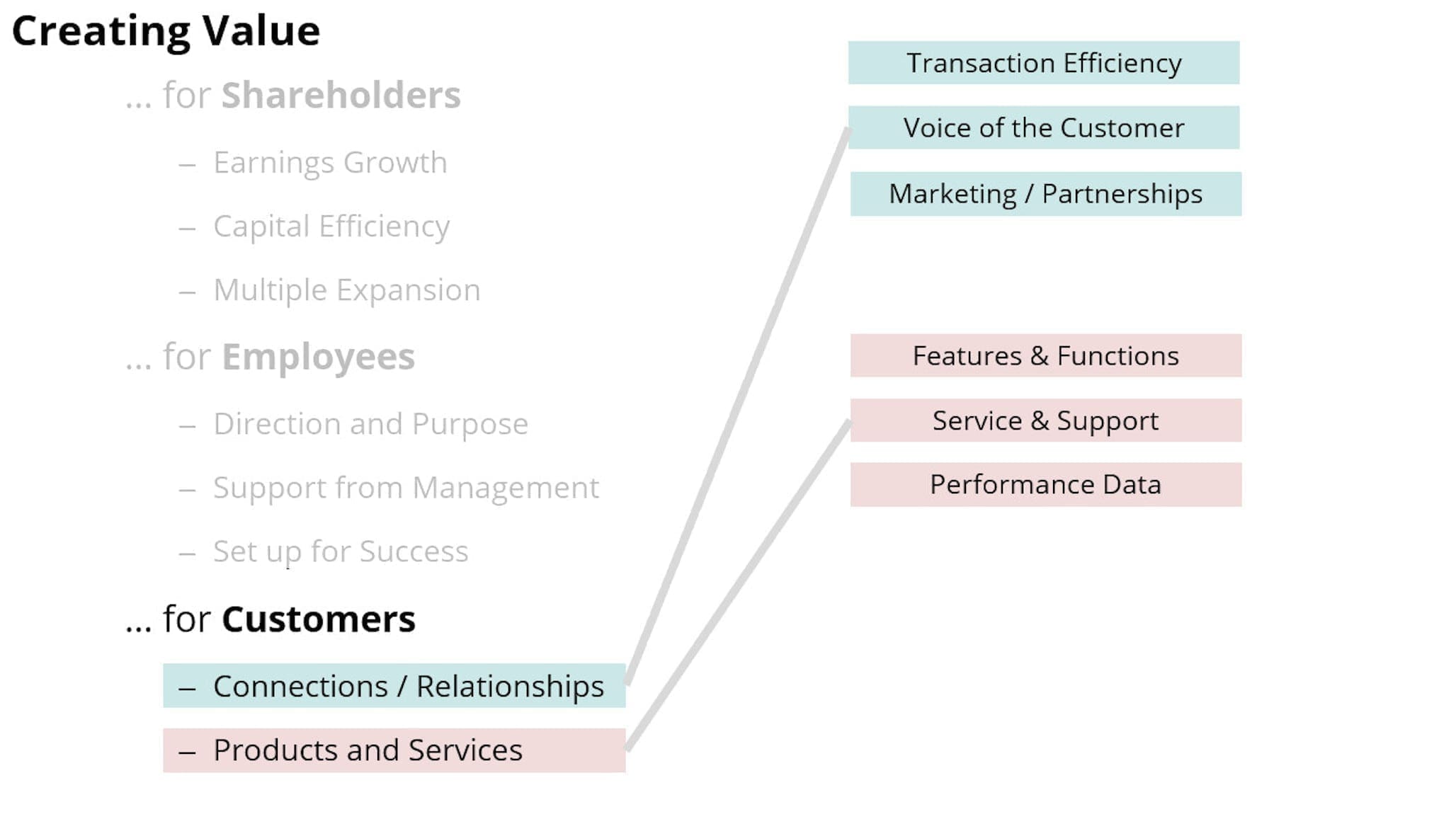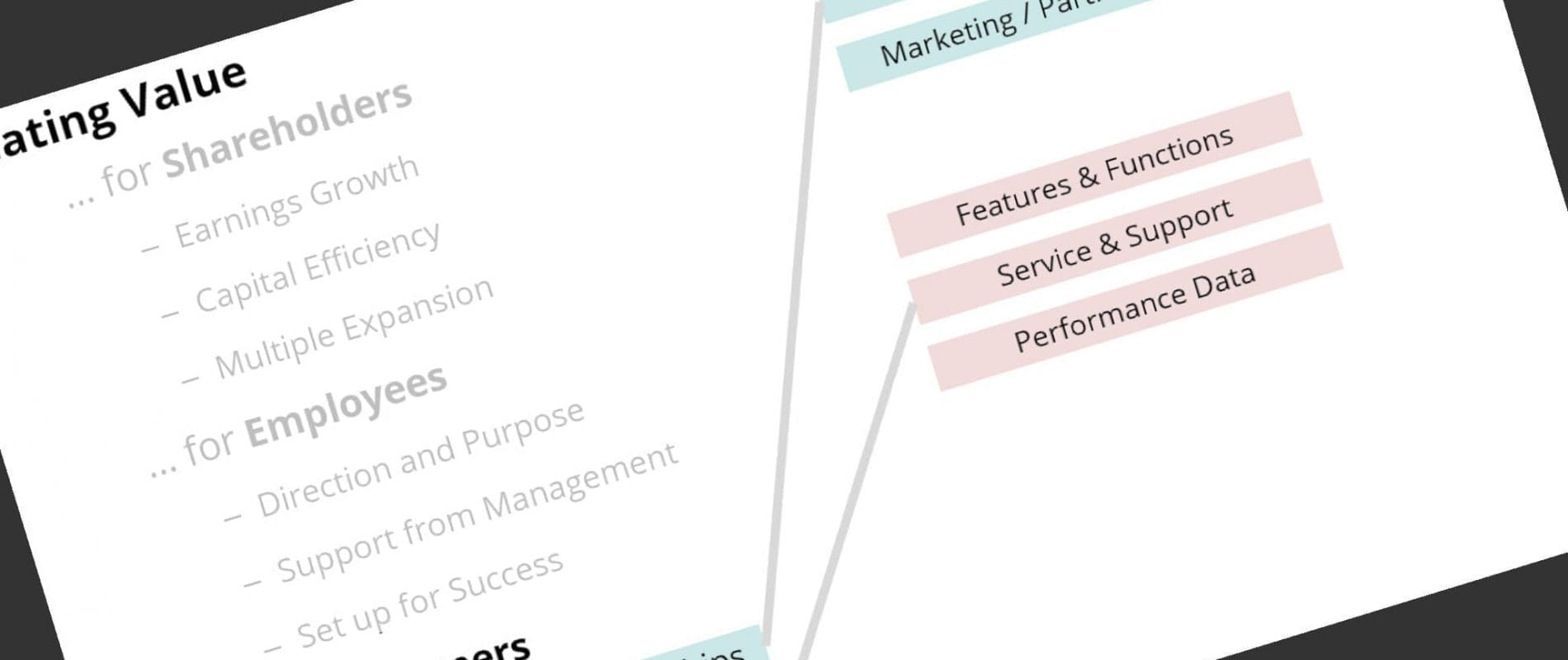A meaningful digital transformation will provide a compelling answer to a simple question: Why? This article focuses on Customer Value; how to create digital value that truly matters for your Customers. (Part of a series of articles about Enterprise Value Creation for Digital Business.)
A business cannot exist without customers. To many, this sounds simplistic and obvious; if you are selling and no one is buying, well, it’s just a form of poetry.
However, if you stick with this over-simplified understanding of your customers, your business may survive – but only when times are good. Even if the economy or the market is friendly for a length of time, a purely transactional relationship with your customers is not truly sustainable.
This is also a naïve oversimplification of the definition of “customer.” Many industries and markets have complex value chains that reach down to the ultimate end-user of products and services. Savvy organizations will pay attention to all of the links in their customer value chain.
Digital business brings many new ways of creating digital value for your customers – which in turn will make your company more resilient and more valuable.
Great Stock vs. Great Company
As discussed earlier in this series, there are two competing goals for most companies. The first focuses on value for the shareholders (owners) that is sustained over time and is geared towards creating a Great Stock.
Not all organizations hold this idea of value for the shareholders as the primary reason for their existence. Sometimes the focus is on the employees – the people that do the day-to-day work, connect with the customer, and create and service the products that you sell. Other times, the focus is on the customer – deeply understanding their needs, and bringing joy and satisfaction with great products that solve real problems.
Focusing on your customers and your employees is all about creating a Great Company – one that provides a great product, keeps your customers happy, and is a great place to work every day. Our last article focused on Employees – now, how can we create value for our Customers?
Great Company, Part 2 – Digital Value for the Customer
Let’s be frank; customer service is core, foundational stuff. Businesses have been thinking and talking about how they serve their customers since the beginning. The smart ones have developed metrics like Net Promoter Score, On-Time Delivery, and Customer Scorecards, and use these to manage more effectively.
Most organizations use the term Customer Satisfaction to characterize their efforts with customers. If you think about it, that mentality can be a bit reactive and inwardly focused. How do my customers perceive me? Is that truly the relationship we want?
Let’s look at this from the customers’ perspective; are you working to create value for your customers based on what they truly need? Are you listening to your customers, working to solve their problems? Or are you merely looking for ways they might use your particular solution or service?
Changing the Language – Customer Obsession
A few years ago, Satya Nadella, CEO of Microsoft, introduced a new mission statement for the company. He definitively talked about the concept of being “customer obsessed” – as an opportunity to exercise a growth mindset every day.
We will learn about our customers and their businesses with a beginner’s mind and then bring solutions that meet their needs. We will be insatiable in our desire to learn from the outside and bring that knowledge into Microsoft, while still innovating to surprise and delight our users.
(emphasis added)
This is a significantly different way of thinking about the customer…
… not just taking care of what they are asking for, but really understanding what they need
… not just stopping at what they are asking for, but understanding what else is possible
How can your company embrace these ideas? At the highest level, value for your customers can be identified in two specific ways.
- Connections / Relationships: How we do what we do – and how our customers interact with us. Do we understand our total relationship with the customer? Do we make every part of that relationship – from problem to solution and every transaction in between – as friction-free as possible?
- Product and Services: Our unique and powerful value-add for our customers. Do we listen to the voice of the customer, and build the answer to their challenges into our products and services? Do we pay attention to unmet needs – and use our innovation and engineering skills to solve these new challenges?
These are pretty basic ideas – “what we do” and “how we do it,” with a focus on the customer’s experience. As shown in the diagram, we can illustrate these ideas with specific examples – powerful levers that we can use to characterize our time investments to make sure we are aligned.

Connections / Relationships can refer to …
- Transaction Efficiency: Are we easy to do business with? Is the product/service discovery process as easy as possible? Can we automate transactions and make the fulfillment journey highly visible – taking the friction out of the buying experience?
- Voice of the Customer: Do we actively listen to our customers’ needs? Can we target our most valuable customers, and spend time with them to truly understand the challenges they face – and the opportunities for great product ideas that may be there?
- Marketing / Partnerships: Do we sufficiently educate our customers on the capabilities of our products? Do we seek to build real partnerships, looking at the lifetime (and future) value that our services will deliver?
Products and Services can refer to …
- Features & Functions: Can we apply our design and engineering skills to solve unmet needs? Are their new capabilities with materials, sensors, and controls to add functions that make our products easier to use?
- Service & Support: Can we take the friction out of the customer and technical support process? Do out products and services evolve over time, based on customer feedback, in a way that pays attention to how the customer works, every day?
- Performance Data: Can we collect data – about the transaction process, the product status, and live operational data – and use it to address product functionality and quality? Can we also use that data to drive even more friction out of the customers’ life (easier to buy/reorder, easier to support)?
Tying Customer Obsession to Digital Transformation
Your customer is one of the five components of a great digital business. It makes sense that customer obsession will be central to your digital transformation. What are some examples of Digital Opportunities here?
- Operations: Implementing EDI connections with customers to automate product reordering, monitoring stock levels, and receiving demand signals
- Customers: Adding customer life-cycle, “big picture” information to CRM and Customer Service processes
- Products: Based on customer feedback and insights, incorporating sensors into products to monitor for particular trouble conditions
- Data: Publish more data and information about product capabilities, costs, availability, and improvements, in formats that customers can use in their workflows
- Team: Send production line and back-office people on customer visits. For folks that do not typically work directly with the customer, this exposure will personalize their work and help them empathize with the person using the products and services your teams create.
Having a terrific market position, a differentiating product feature, and amazing onboard talent are significant assets. Still, if you genuinely want a scalable and sustainable business, the customer is and always will be king.
Up Next: Tying Value Creation to Digital Transformation
13 July, 2020






Comments (0)